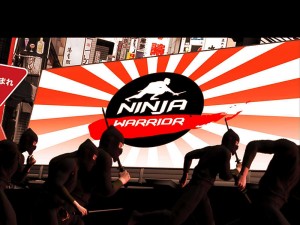Sasuke Mania
In class we have discussed the Otaku culture in Japan, and how it is perceived by through the media, and within certain social frames. While there are similar social phenomena in the United States within certain communities (gaming, comic book, etc), I would argue that the otaku lifestyle seems to be a uniquely Japanese occurrence. I find this to be true because unlike American geek communities Otaku have a stronger influence on greater Japanese culture and lifestyle, which is evident through the existance of locations like Akihabara (certain similar American communities have not yet reached a level of influence that they have entire neigborhoods). Generally an otaku is an individual whose life is governed by their obsessions, that generally relate to gaming, anime, manga, dame, and other virtual experiences.
The otaku lifestyle is interesting because it is viewed by some as a positive celebration of certain aspects of culture, but by others as an antisocial depression induced/inducing condition. According to otaku academic, anime producer, and author, Toshio Okada, there are currently 10 million Japanese people who he would define as being otaku. This makes up approximately 1/13th of Japan’s population (Interview).
Because of multiple highly public murder cases (Tsutomu Miyazaki and Kaoru Kobayashi are example)s in which the perpetrators of the crimes were otaku, otakudom has gained a quite negative public fascination.

Kaichiro Morikawa
This is compounded by the antisocial attributes already attributed to otakudom by the public. Kaichiro Morikawa, a Japanese academic who works with “Theories of Design” (Kaichiro Morikawa website in Japanese), argues that another culture exists within Japan that shares some similarities with the otaku population but deviates from the culture in several significant ways. This group is known as “mania” .
While mania are also known to have life affecting obsessions, Morikawa says that there are three major differences between Otaku culture and mania culture. According to Morikawa the first difference between the two camps is that mania are often socially able and active within society, while Otaku are infamous for being unfriendly and reclusive.
The second difference is that mania’s obsessions often deal with things which are tangible and material. This differs from Otaku who obsess over virtual realities, and magna related fantasies. It could be argued however, that this distinction is not legitimate in that certain Otaku interests are experienced in the physical realm, such as an individual creating Manga related art, or engaging in cosplay. I would argue however, that even those these activities are physical, the worlds and greater stories that the physical actions are based on, are fantasy related. While an otaku might spend their time following an obsession of a Manga and create costumes of his or her favorite character, a mania might spend time studying train tracks which he or she is physically able to experience in real life. It is possible that one of the reasons mania has a more positive image is that the obsessions tend to concentrate on subjects that are tangible. This could be attributable to the fact that outsiders who do not understand the fantasy world’s which create otaku obsessions, they could more easily relate to something that they have experianced like trains or sports fanaticism.
The third distinction between the two social groups comes from the nature of the obsession. Mania generally choose one subject to obsess over, while otaku often embrace many different aspects of obscure culture (Interview).
I find the distinction between mania and otaku interesting because it helps me to better understand one of my favorite aspects of Japanese culture that I have been subjected to growing up, Sasuke. Sasuke, or Ninja Warrior, as it is known in the United States is a physical challenge television game show made in Japan which I watched frequently throughout high school. The aspect of Sasuke that appeals to me the most is the extreme dedication to and obsession of the competition that most of the competitors exhibit. Out of the 25 Sasuke television specials there are multiple athletes who have competed every time.
Out of the 25 Sasuke television specials there are multiple athletes who have competed every time.
There are many competitors who have a mania-like obsession with Sasuke. These competitors go to great lengths to train for the competition often rebuilding physical obstacles at their homes or places of employment. While these athletes are all completely obsessed with competing in Sasuke, they seem to fit into the mania social group over the Otaku. This is because the athletes are shown on the show as being socially able, and often their home lives are featured to give deeper background. It is also important to note that the shows objectives in showing the contestants home lives, may be in attempting to create a specific image of Sasuke that consciously seperates itself from otakudom. Also the athletes are obsessed with physical challenges, not fantasies. The athletes also match the third criteria of mania culture by generally dedicating their obsession to only Sasuke. Many of the athletes have jobs only to afford their training equipment and competing (Ninja Warrior). It is interesting that the criteria that seperate mania culture from otaku culture also seems to draw it closer to various cultures within the United States. This could be true for someone who follows baseball and game statistics in an obsessed fashion.

An obstacle from the first tage of Sasuke
Sasuke differentiates itself from most other physical challenge shows I personally have seen, by being much more difficult. Even though there have been 25 Sasuke

Kazuhiko Akiyama: The first competitor to win Sasuke. After going blind Akiyama continued to train for and compete in Sasuke.
competitions, and in each competition 100 athletes compete, there have only ever been three champions of Sasuke. The video bellow features member of the Sasuke-mania culture Makoto Nagano. Nagano is a member of six competitors called the “Sasuke All Stars” who have become famous for their impressive performances, and dedication to the competition. The start of the video shows some of Nagano’s impressive training which occurs on his boat.
While otaku culture may have gained a very negative social connotation, especially in the United States, mania does not have the same social stigma. It is important to note however, that it is entirely possible for mania culture to have negative repurcutions for those engaging in it. An example of this could be if an individual spent an amount of money beyond their means on their obsession. Sasuke is just one example of mania lifestyle, and it’s acceptance in the United States.
For more information about Sasuke check the fan-based website .
Discussion Questions:
Morikawa’s definition of mania in opposition to otakudom is legitimate? Do the two need to be separated, or are the so related that the distinction is mute?
While Sasuke is a culturally harmless show, and mania culture is definitionally less socially harmful then otakudom, is it possible for there to be significant negative social repercussions of mania culture?
Sources:
1)”Ninja Warrior – G4tv.com.” Ninja Warrior. G4TV. Web. <http://g4tv.com/ninjawarrior/>.
2)Okada, Toshio. “Otaku Talk.” Interview by Takashi Murakami and Kaichiro Morikawa. Japan Society. Web. <http://www.japansociety.org/content.cfm?page=otaku_talk>.
3)”Archive of Studies.” Kaichiro MORIKAWA Website. Ed. Kaichiro Morikawa. Web. <http://homepage1.nifty.com/straylight/main/index_en.html>.
4)”The Cannibal Nerd: The Rise and Fall of Tsutomu Miyazaki | Dr. Killer Network.” Dr Killer : The Stories of Serial Killers, Cannibals, Murderers. Web. 2010. <http://www.drkiller.net/the-cannibal-nerd-the-rise-and-fall-of-tsutomu-miyazaki.html>.
5) NinjaWarrior.us | The #1 Sasuke/Ninja Warrior Fan Site. Web. 2010. <http://ninjawarrior.us/>.
This is for me (as a consumer of virtual worlds which make one “Otaku”) a very interesting topic.
I have two points I wish to raise with you, however.
1st, I think it is a mistake to view otaku culture as distinct to Japan. We too have geeks and geek culture where the minutia of fantasy worlds are obsessed over. Look at trekkies, tabletop gamers, and the like. Certainly the perception of such groups in Japan is distinctly negative–perhaps because of these murder incidents you mention–but it would be a mistake I think to view otakudom as unique to Japan.
2nd, I question this distinction between the virtual and the material as being the defining difference between mania and otakudom. Otaku and geek culture often puts large store in collecting. There must be a material link to the virtual world, after all. Similarly, with Ninja Warrior, though undeniably physical in nature, I would posit that there is an element of fantasy as well. After all, it is a game, one created by television companies in order to draw viewers. Can we really view this as divorced from the virtual?
Max,
I was certainly fascinated to read about “mania,” as I had never heard of it before. What are some examples other than Sasuke that mania would apply to?
You ask if there can be negative effects of mania culture, and I would argue that there certainly can be. For example, what kind of monetary investment is made in replicating Sasuke obstacles? Is it not similar to the Otaku’s desire for collector goods? There is an emphasis in the show on the family lives of the contestants, but to what extent are these valid examinations and not just pandering to an image.
What are U.S. understandings of mania? Are football and baseball “nuts” in the U.S. exhibiting mania as well? Where is the line between being a fan and having or being mania? If it is all obsession, why do we view the physical as superior to the virtual?
Sportstation mania is news about Indonesian sports, if you want to know further information, please visit our website.https://medium.com/@sakura.ichiru1998